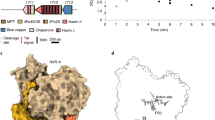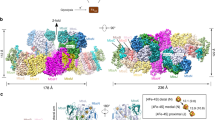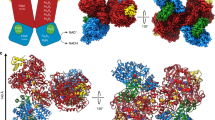Abstract
We have determined the structure of rubrerythrin, a non-haem iron protein from the anaerobic sulphate-reducing bacterium, Desulfovibrio vulgaris (Hildenborough), by X-ray crystallography. The structure reveals a tetramer of two-domain subunits. Each subunit contains a four-helix bundle surrounding a diiron-oxo site and a C-terminal rubredoxin-like FeS4 domain. The diiron-oxo site contains a larger number of carboxylate ligands and a higher degree of solvent exposure than do those in other diiron-oxo proteins. The four-helix bundle of rubrerythrin closely resembles those of the ferritin and bacterioferritin subunits, suggesting a relationship among these proteins—consistent with the recently demonstrated ferroxidase activity of rubrerythrin.
This is a preview of subscription content, access via your institution
Access options
Subscribe to this journal
Receive 12 print issues and online access
$189.00 per year
only $15.75 per issue
Buy this article
- Purchase on Springer Link
- Instant access to full article PDF
Prices may be subject to local taxes which are calculated during checkout
Similar content being viewed by others
References
Moura, I., Tavares, P. & Ravi, N. Characterization of 3 proteins containing multiple iron sites - Rubrerythrin, desulforedoxin, and a protein containing a six-iron cluster. Meth. Enz. 243, 216–240 (1994).
Dave, B.C., Czernuszewicz, R.S., Prickril, B.C. & Kurtz, D.M., Jr. Resonance raman spectroscopic evidence for the FeS4 and Fe-O-Fe sites in rubrerythrin from Desulfovibrio vulgaris. Biochemistry 33, 3572–3576 (1994).
Ravi, N., Prickril, B.C., Kurtz, D.M., Jr & Huynh, B.H. Spectroscopic characterization of 57Fe-reconstituted rubrerythrin, a non-heme iron protein with structural analogies to ribonucleotide reductase. Biochemistry 32, 8487–8491 (1993).
Pierik, A.J., Wolbert, R.B.G., Portier, G.L., Verhagen, M.F.J.M. & Hagen, W.R. Nigerythrin and rubrerythrin from Desulfovibrio vulgaris each contain 2 mononuclear iron centers and 2 dinuclear iron clusters. European Journal of Biochemistry 212, 237–245 (1993).
Gupta, N. et al. Recombinant Desulfovibrio vulgaris rubrerythrin. Isolation and characterization of the diiron domain. Biochemistry 34, 3310–3318 (1995).
Prickril, B.C., Kurtz, D.M., Jr. LeGall, J. & Voordouw, G. Cloning and sequencing of the gene for Rubrerythrin from Desulfovibrio vulgaris (Hildenborough). Biochemistry 30, 11118–11123 (1991).
Kurtz, D.M., & Prickril, B.C. Intrapeptide sequence homology in rubrerythrin from Desulfovibrio vulgaris: Identification of potential ligands to the diiron site. Biochemical and Biophysical Research Communications 181, 337–341 (1991).
Nordlund, P. & Eklund, H. Di-iron-carboxylate proteins. Current Opinion in Structural Biology 5, 758–766 (1995).
Rosenzweig, A.C., Frederick, C.A., Lippard, S.J. & Nordlund, P. Crystal structure of a bacterial non-haem iron hydroxylase that catalyses the biological oxidation of methane. Nature 366, 537–543 (1993).
Rosenzweig, A.C., Nordlund, P., Takahara, P.M., Frederick, C.A. & Lippard, S.J. Geometry of the soluble methane monooxygenase catalytic diiron center in two oxidation states. Chemistry & Biology 2, 409–418 (1995).
Nordlund, P., Sjöberg, B.-M. & Eklund, H. Three dimensional structure of the free radical protein of ribonucleotide reductase. Nature 345, 593–598 (1990).
Nordlund, P. & Eklund, H. Structure and function of the Escherichia coli ribonucleotide reductase protein R2. J. Mol. Biol. 231, 123–164 (1993).
Widell, L.C. & Hansen, T.A. The dissimilatory sulphate-reducing and sulfur-reducing bacteria. in The Prokaryotes (eds. A. Balows, H.G. Dworkin, W. Harder, & K.H. Schleifer) 583–624 (Springer-Verlag, New York, 1992).
Liu, M.Y. & LeGall, J. Purification and characterization of two proteins with inorganic pyrophosphatase activity from Desulfovibrio vulgaris: Rubrerythrin and a new, highly active, enzyme. Biochem. Biophys. Res. Commun. 171, 316–318 (1990).
Feig, A.L. & Lippard, S.J. Reactions of non-heme iron (II)centers with dioxygen in biology and chemistry. Chemical Reviews 94, 759–805 (1994).
Kurtz, D.M., Jr. Iron: Proteins with dinuclear active sites in Encyclopedia of Inorganic Chemistry (ed. King, R.B.) 1847–1859 (Wiley, Chichester, UK, 1994).
Stenkamp, R.E. Dioxygen and hemerythrin. Chemical Reviews 94, 715–726 (1994).
Fox, B.C., Shanklin, J., Ai, J., Loehr, T.M. & Sanders-Loehr, J. Resonance Raman evidence for anFe-O-Fe center in stearoyl-ACP destaurase. Primary sequence identity with other diiron-oxo proteins. Biochemistry 33, 12776–12786 (1994).
Harrison, P. & Lilley, T.H. Ferritin in Iron Carriers and Iron Proteins (ed. ^(eds. Loehr, T.M.) 123–237 (VCH Publishers, New York, 1989).
Hempstead, P.D. et al. Direct observation of the iron binding sites in a ferritin. FEBS Letters 350, 258–262 (1994).
Frolow, F., Kalb(Gilboa), J. & Yariv, J. Structure of a unique two-fold symmetric haem-binding site. Nature Struct. Biology 1, 453–460 (1994).
Bonomi, F., Kurtz Donald, M., Jr. & Cui, Xizoyuan. Ferroxidase activity of recombinant Desulfovibrio vulgaris rubrerythrin. J. Inorg. Biochem. 1, 69–72 (1996).
Sieker, L.C., Turley, S., Prickril, B.C. & LeGall, J. Crystallisation and preliminary X-ray diffraction study of a protein with a high potential rubredoxin center and a hemerythrin-type Fe center. Proteins: Struct., Funct. Genets 3, 184–186 (1988).
Kurtz, D.M., Jr. Oxo- and hydroxo-bridged diiron complexes: A chemical perspective on a biological unit. Chemical Reviews 90, 585–606 (1990).
Sieker, L.C., Stenkamp, R.E. & LeGall, J. Rubredoxin in Crystalline State in Meth Enzymol. 243, 203–216 (1994).
Day, M.W. et al. X-ray crystal structures of the oxidized and reduced forms of rubredoxin from the marine hyperthermophilic archaebacterium Pyrococcus furiousus. Prot. Sci. 1, 1494–1507 (1992).
Adman, E., Watenbaugh, K.D. & Jensen, L.H. NH⋯Hydrogen bonds in Peptococcus aerogenes ferredoxin, Clostridium pasteurianum rubredoxin, and Chromatium vinosum high potential iron protein. Proc. Nat. Acad. Sci. USA 72, 4854–4858 (1975).
Holm, L. & Sander, C. Dali: A network tool for protein structure comparison. Trends in Biochemical Sciences 20, 478–480 (1995).
Andrews, S.C., Smith, J.M.A., Yewdall, S.J., Guest, J.R. & Harrison, P.M. Bacterioferritins and ferritins are distantly related in evolution. FEBS Letters 293, 164–168 (1991).
Lawson, D.M. et al. Identification of the ferroxidase centre in ferritin. FEBS Letters 254, 207–210 (1989).
Bauminger, E.R. et al. lron(II)oxidation and early intermediates of iron-core formation in recombinant human H-chain ferritin. Biochem. J. 296, 709–719 (1993).
Treffry, A., Zhao, Z., Quail, M.A., Guest, J.R. & Harrison, P.M. Iron(II) Oxidation by H chain ferritin: Evidence from site-directed mutagenesis that a transient blue species is formed at the dinuclear iron center. Biochemistry 34, 15204–15213 (1995).
Chen-Barrett, Y. et al. Tyrosyl radical formation during the oxidative deposition if iron in human apoferritin. Biochemistry 34, 7847–7853 (1995).
Yoshida, K. et al. A mutation in the ceruloplasmin gene is associated with systemic hemosiderosis in humans. Nature Genetics 9, 267–273 (1995).
Kabsch, W.J. Automatic Processing of Rotation diffraction Data from Crystals of Initially Unknown Symmetry and Cell Constants. J. of Appl Crystallogr. 26, 795–800 (1993).
Collaborative Computational Project, N.4. The CCP4 suite: Programs for protein crystallography. Acta Crystallographica D50, 760–763 (1994).
Otwinowski, Z. in CCP4 Proceedings 80–88 (Daresbury Laboratories, Warrington, UK, 1991).
Brünger, T.A., Kuriyan, J. & Karplus, M. Crystallographic R Factor refinement by molecular dynamics. Science 235, 458–460 (1987).
Jones, T.A., Zou, J.Y., Cowan, S.W. & Kjeldgaard, M. Improved methods for the building of protein models in electron density maps and the location of errors in these models. Acta Crystallographica A47, 110–119 (1991).
Lawson, D.M. et al. Solving the structure of human H ferritin by genetically engineered intermolecular crystal contacts. Nature 349, 541–544 (1991).
Bernstein, F.C. et al. The protein data bank: a computer-based archival file for macromolecular structures. J. Mol. Biol. 112, 535–542 (1977).
Laskowski, R.A., MacArthur, M.W., Moss, D.S. & Thornton, J.M. PROCHECK: A Program to Check the Stereochemical Quality of Protein Structures. Journal of Appl. Crystallogr. 26, 283–291 (1993).
Kraulis, P.J. MOLSCRIPT: A Program to Produce Both Detailed and Schematic Plots of Protein Structures. J. of Appl. Crystallogr. 24, 946–950 (1991).
Merritt, E.A. & Murphy, M.E.P. Raster3D Version 2.0: A Program for Photorealistic Molecular Graphics. Acta Crystallographica D50, 869–873 (1994).
Nicholls, A., Sharp, K.A. & Honig, B. Protein folding and association: Insights into the interracial and thermodynamic properties of hydrocarbons. PROTEINS 11, 281–296 (1991).
Author information
Authors and Affiliations
Rights and permissions
About this article
Cite this article
deMaré, F., Kurtz, D. & Nordlund, P. The structure of Desulfovibrio vulgaris rubrerythrin reveals a unique combination of rubredoxin-like FeS4 and ferritin-like diiron domains. Nat Struct Mol Biol 3, 539–546 (1996). https://doi.org/10.1038/nsb0696-539
Received:
Accepted:
Issue Date:
DOI: https://doi.org/10.1038/nsb0696-539
This article is cited by
-
The multidomain flavodiiron protein from Clostridium difficile 630 is an NADH:oxygen oxidoreductase
Scientific Reports (2018)
-
Electron carriers in microbial sulfate reduction inferred from experimental and environmental sulfur isotope fractionations
The ISME Journal (2018)
-
The dual function of flavodiiron proteins: oxygen and/or nitric oxide reductases
JBIC Journal of Biological Inorganic Chemistry (2016)
-
Genomic properties of Marine Group A bacteria indicate a role in the marine sulfur cycle
The ISME Journal (2014)
-
Protein fractionation and detection for metalloproteomics: challenges and approaches
Analytical and Bioanalytical Chemistry (2012)



